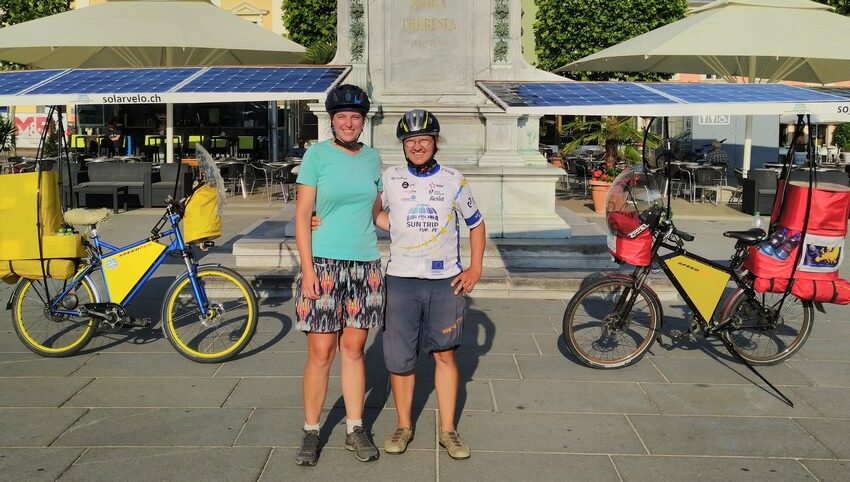 The choice of the type of our 2 solar bikes is linked to my professional history: I am Daniel, husband of Sibylle, and by integrating the company Swiss-urbanbikes which manufactures the Speedped, I found myself at the source of components of the best choice. I then converted our daily bikes, with the concern to keep it as simple as possible.
The choice of the type of our 2 solar bikes is linked to my professional history: I am Daniel, husband of Sibylle, and by integrating the company Swiss-urbanbikes which manufactures the Speedped, I found myself at the source of components of the best choice. I then converted our daily bikes, with the concern to keep it as simple as possible. 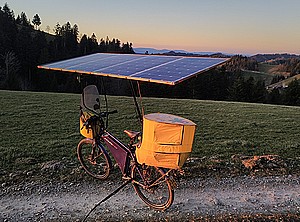 The peculiarity of their design lies in the small 500W motor placed in the rear triangle of the frame and which shares a sprocket with the chain or belt of the bottom bracket. It works like a pedal motor without exerting double force on the chain and without any need for a huge reduction on the chain that rotates quite slowly. At most, the motor can provide 800w continuously if it is in the right rpm. This last point is essential (maintaining the right rpm) because at this power, the engine temperature reaches 100 ° C! This particular design allowed me to travel the 12000 km of Suntrip China in 2018.
The peculiarity of their design lies in the small 500W motor placed in the rear triangle of the frame and which shares a sprocket with the chain or belt of the bottom bracket. It works like a pedal motor without exerting double force on the chain and without any need for a huge reduction on the chain that rotates quite slowly. At most, the motor can provide 800w continuously if it is in the right rpm. This last point is essential (maintaining the right rpm) because at this power, the engine temperature reaches 100 ° C! This particular design allowed me to travel the 12000 km of Suntrip China in 2018.
Detailed technical overview
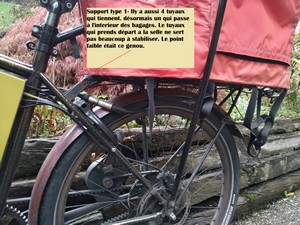 The frame of the bike is made of Steel. Maxxis Overdrive excell tires are 26×2.0 on riveted rims. The disappointing experience of the Schwalbe Marathon (perfect assembly difficulty, longevity of less than 11,000km on the Sun Trip Europe, irregular profile), has made me now retain Maxxis Overdrive excell that has been on my bike for 16,000km already. The rear hub is a Shimano Alfine 8-speed. For long climbs of more than 15%, the 1st gear is too high compared to the weight of the loaded bike. The hub is very reliable. The front fork is a Suntour 100mm with steel pin painted in the colors of the frame, a simple Suntour having already played its role well for the Sun Trip China.
The frame of the bike is made of Steel. Maxxis Overdrive excell tires are 26×2.0 on riveted rims. The disappointing experience of the Schwalbe Marathon (perfect assembly difficulty, longevity of less than 11,000km on the Sun Trip Europe, irregular profile), has made me now retain Maxxis Overdrive excell that has been on my bike for 16,000km already. The rear hub is a Shimano Alfine 8-speed. For long climbs of more than 15%, the 1st gear is too high compared to the weight of the loaded bike. The hub is very reliable. The front fork is a Suntour 100mm with steel pin painted in the colors of the frame, a simple Suntour having already played its role well for the Sun Trip China.  The weight of the set without luggage and with the 2kwh battery is 54kg. The panel alone weighs about 13.5kg with EPDM rubber protective edge. The main luggage is placed at the back in the 70l box in two stages. In the back of the saddle we put 4×1.5l bottles at the max. This accommodation also hosts 2 boost transformers. (1x Genasun and 1x CTK EV 300) In addition, 2 sausages mounted with Klett contain the tent, the mattress and the sleeping bag. Behind the Zipper breeze headlight is a crate to put the bag with the valuables, some food, etc. There is also a simple attachment for GPS, a USB socket and a smartphone holder made from a shampoo bottle. Visibility must be neat because it is very important. For this, I installed powerful position lights on the back and front (simple diagram to find on solarvelo.ch). To park our bikes that have a very high point of gravity, the kickstand must be adapted. It has a length of about 90cm, weighs 1.2kg and is located towards the attachment in the middle of the frame. She and pulls up backwards. It is an important point to be able to quickly park your bike without always needing a wall or installing something, which complicates the operation. The design of our bikes is deliberately flexible: the panels dance on the bike. Round shock absorbers and a front bracket that rotates the panel on the extension of the fork shaft are used. This assembly makes it possible to limit excessive efforts but despite everything, some breakage of the steel by fatigue are to be deplored.
The weight of the set without luggage and with the 2kwh battery is 54kg. The panel alone weighs about 13.5kg with EPDM rubber protective edge. The main luggage is placed at the back in the 70l box in two stages. In the back of the saddle we put 4×1.5l bottles at the max. This accommodation also hosts 2 boost transformers. (1x Genasun and 1x CTK EV 300) In addition, 2 sausages mounted with Klett contain the tent, the mattress and the sleeping bag. Behind the Zipper breeze headlight is a crate to put the bag with the valuables, some food, etc. There is also a simple attachment for GPS, a USB socket and a smartphone holder made from a shampoo bottle. Visibility must be neat because it is very important. For this, I installed powerful position lights on the back and front (simple diagram to find on solarvelo.ch). To park our bikes that have a very high point of gravity, the kickstand must be adapted. It has a length of about 90cm, weighs 1.2kg and is located towards the attachment in the middle of the frame. She and pulls up backwards. It is an important point to be able to quickly park your bike without always needing a wall or installing something, which complicates the operation. The design of our bikes is deliberately flexible: the panels dance on the bike. Round shock absorbers and a front bracket that rotates the panel on the extension of the fork shaft are used. This assembly makes it possible to limit excessive efforts but despite everything, some breakage of the steel by fatigue are to be deplored.
Detailed description of the electrical system
Motor: Speeped 500W (speedped.com -the motor cannot be purchased without a bike.)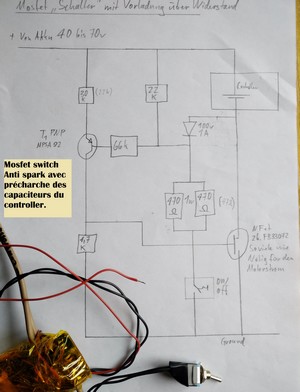 Controller: Vesc. 4.12 (open source e-skateboard controller on aliexpress, do not buy from maytech) and Mosfet Switch (to unplug the controller, diagram opposite.) Sensors: Brake, Clutch, PAS, Potentiometer. Battery: 14s8P (52V 40Ah) Smart BMS with Bluetooth possibility. Cycle Analyst 3 Solar: motor control by PAS, button switch, speed control, AC-independent sensors). DC/DC: 5V 3A USB, Lights (except front) = 6V 0.5A, regulator current 0.8A for front light. Solar chargers: 1x Genasun + 1x CTK ev 300 panels 3x 160Wp CCS (Cheap Chinese Shit). In the end, they still do not hold badly. In the future, I will buy Solbians at 3x the price. The panels are glued to carbon frames, independently of each other. One panel is connected to the Genasun and the other two (parallel or series possible) are connected to the CTK.
Controller: Vesc. 4.12 (open source e-skateboard controller on aliexpress, do not buy from maytech) and Mosfet Switch (to unplug the controller, diagram opposite.) Sensors: Brake, Clutch, PAS, Potentiometer. Battery: 14s8P (52V 40Ah) Smart BMS with Bluetooth possibility. Cycle Analyst 3 Solar: motor control by PAS, button switch, speed control, AC-independent sensors). DC/DC: 5V 3A USB, Lights (except front) = 6V 0.5A, regulator current 0.8A for front light. Solar chargers: 1x Genasun + 1x CTK ev 300 panels 3x 160Wp CCS (Cheap Chinese Shit). In the end, they still do not hold badly. In the future, I will buy Solbians at 3x the price. The panels are glued to carbon frames, independently of each other. One panel is connected to the Genasun and the other two (parallel or series possible) are connected to the CTK. 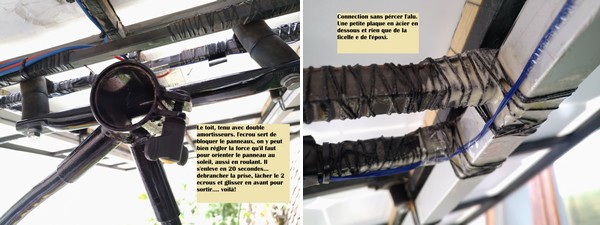 Part Y: as soon as the chargers are placed, upstream of the battery are installed a cable and a piece Y that allow you to connect the panels of both bikes to a battery! Mandatory if you travel as a couple! Half an hour every two or three days was enough for us to avoid the problem of empty battery and full battery between the two bikes. On Sun Trip Europe, we had to balance the load of our bikes every two or three days. It was quite long to plug the two panels into a battery for half an hour. That’s 300 Wh.
Part Y: as soon as the chargers are placed, upstream of the battery are installed a cable and a piece Y that allow you to connect the panels of both bikes to a battery! Mandatory if you travel as a couple! Half an hour every two or three days was enough for us to avoid the problem of empty battery and full battery between the two bikes. On Sun Trip Europe, we had to balance the load of our bikes every two or three days. It was quite long to plug the two panels into a battery for half an hour. That’s 300 Wh.
Feedback
For Daniel …
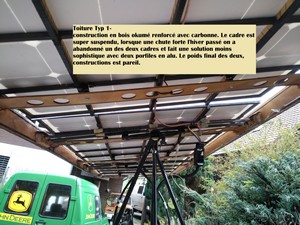 The strong point of our bikes is the great solar power compared to the weight. A sunny day is easily enough for us to travel 250km with an average speed around 33km/h (see the statistics of Sun Trip Europe on solarvelo.ch). The solar roof protects from the sun and combined with the windshield, not bad against rain. With a surface of 2.5m2 and a length of 3.2m, the panel is really big (Production of a beautiful day: 2.5 to 3 kW/h). The bike rides like a motorcycle and is no longer as agile as a standard bike. At high speed (70kmh) it is always stable and does not guide. It is adapted to everyday life and is also our main vehicle to move around. Before Sun Trip Europe, my wife traveled more than 20,000km in just over a year. During the winter, we have to dismantle the solar panel and mount spike tires because we live at 850m altitude in a narrow and dark valley.
The strong point of our bikes is the great solar power compared to the weight. A sunny day is easily enough for us to travel 250km with an average speed around 33km/h (see the statistics of Sun Trip Europe on solarvelo.ch). The solar roof protects from the sun and combined with the windshield, not bad against rain. With a surface of 2.5m2 and a length of 3.2m, the panel is really big (Production of a beautiful day: 2.5 to 3 kW/h). The bike rides like a motorcycle and is no longer as agile as a standard bike. At high speed (70kmh) it is always stable and does not guide. It is adapted to everyday life and is also our main vehicle to move around. Before Sun Trip Europe, my wife traveled more than 20,000km in just over a year. During the winter, we have to dismantle the solar panel and mount spike tires because we live at 850m altitude in a narrow and dark valley. 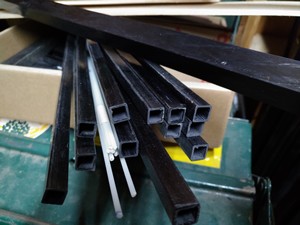 There are always things to improve. On Sibylle’s bike, we redid the rear bracket, just before the Sun Trip Alpes 2022 because she wanted the panel lower. Halfway through the trip, the structure suffered from a fatigue breakage. It is advantageous to have several supports, and it does not matter if you have a breakage: steel is easy to weld and you can easily find steel pipes cut in half as well as fixing systems … Another means of makeshift repair: epoxy resin (or Araldite etc.) with choking and string. Subject to a stop to let the glue harden, very solid repairs can be obtained.
There are always things to improve. On Sibylle’s bike, we redid the rear bracket, just before the Sun Trip Alpes 2022 because she wanted the panel lower. Halfway through the trip, the structure suffered from a fatigue breakage. It is advantageous to have several supports, and it does not matter if you have a breakage: steel is easy to weld and you can easily find steel pipes cut in half as well as fixing systems … Another means of makeshift repair: epoxy resin (or Araldite etc.) with choking and string. Subject to a stop to let the glue harden, very solid repairs can be obtained.
For Sibylle … His solar bike, “his dragonfly”
For 2 years now, I have been riding my solar bike. At first it was a big change, because the bike was much heavier than usual. However, I got used to it gradually, as we mounted the frames with the roof, the luggage box, etc. “It is by forging that one becomes a blacksmith”. Another very big change in the riding experience was when I really prepared the bike to transport it for the first time to the starting point of Suntrip-Europe 2021. Solar bikes are generally heavier than normal non-solar electric bikes. As a result, the driving behavior is a little more pushy and less maneuverable. Sharp turns, narrow, bumpy or steep roads, starting and manoeuvring require a little practice. However, my solar bike is stable and calm. I hardly feel anything from dancing or beating the roof while steering. Even at high speeds, my solar bike is very stable. The climb is a bit slower than with a normal electric bike, simply because you have to push more weight uphill. Of course, this also has an effect on brake wear. Brake pads need to be changed more often. Since my solar bike has a very large roof (3.2m x 0.8m), it needs enough space to maneuver. Otherwise, the solar bike can be turned on the spot like a normal bike. When parking, you should pay attention to the wind and always position the solar bike so that the wind presses on the kickstand. This also requires a support surface for the solid kickstand so that it does not sink. Children are not allowed to do gymnastics on the crutch, otherwise it may bend and the bike may fall. I prefer to press my solar bike against a wall, tree or pole and attach it to it with a strap. This is the easiest and safest way to park and the kickstand does not present a risk of dangerous tripping due to its length. I usually don’t like to climb very steep paths. My solar bike then tends to “pitch” because when going up, the weight weighs even more on the rear wheel than on the front wheel. That’s why it’s helpful to lean forward with your upper body. After the Suntrip-Alpes 2022 and all the steep passes, I now feel safer in this situation. Taking enough rest also helps to gather strength to pedal to the next stage.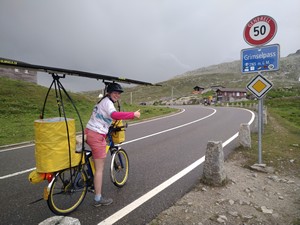 What I appreciate most about my solar bike, in addition to the almost infinite autonomy, is the roof as a source of shade. Even when it rains, you are significantly less wet than without a roof. The windshield is also a great help here. Rain pants and rubber boots are always recommended. The roof also serves as a small first shelter. Thanks to the luggage box, which we designed so that the trunk lid is horizontal when the bike is parked, I always carry a small table with me. This way, I can put my stuff on the unboxed box rather than on the wet floor. Although the luggage box is only closed with Velcro doors, I have never had my luggage visited or stolen. The box offers a volume of about 70 liters; It is divided into two compartments with an intermediate floor. Light things are stored on top, like clothes, and underneath are placed heavier tools, gas stove, etc. We tie the sleeping bag, the small air mattress and the tent in two “sausages”, left and right under the luggage compartment. Thus, luggage is transported relatively compactly.
What I appreciate most about my solar bike, in addition to the almost infinite autonomy, is the roof as a source of shade. Even when it rains, you are significantly less wet than without a roof. The windshield is also a great help here. Rain pants and rubber boots are always recommended. The roof also serves as a small first shelter. Thanks to the luggage box, which we designed so that the trunk lid is horizontal when the bike is parked, I always carry a small table with me. This way, I can put my stuff on the unboxed box rather than on the wet floor. Although the luggage box is only closed with Velcro doors, I have never had my luggage visited or stolen. The box offers a volume of about 70 liters; It is divided into two compartments with an intermediate floor. Light things are stored on top, like clothes, and underneath are placed heavier tools, gas stove, etc. We tie the sleeping bag, the small air mattress and the tent in two “sausages”, left and right under the luggage compartment. Thus, luggage is transported relatively compactly.
My next machine will look like…
That is to say, we are quite happy with our machines as they are. For us, bicycles are the main way to get around: our old Peugeot 106 is perhaps only a third of the kilometers we travel with our bikes. Including the Suntrip Europe, Sibylle has already exceeded 20’000km and me now doing 4x 80km per week, I will catch up. On Sibylle’s bike, we can recreate the rear bracket to find a final version.During the winter we are forced to dismantle the solar and mount spike tires. We live in a valley shaded as a result there is often ice on the road. A next machine? If I found the time, I would embark on the construction of a solar two-wheeled recumbent bike, all suspended that maybe would also have a small motor to brake.
